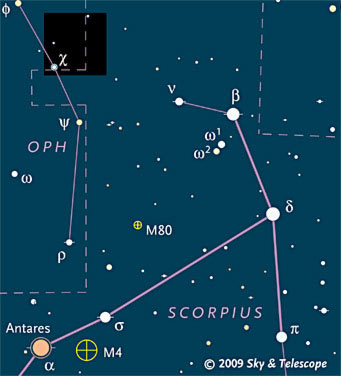Novae explode without warning, and even recurrent novae are pretty unpredictable. (For instance, we've been waiting way too long for T Pyxidis to erupt again; see Sky & Telescope, April 2002, page 93).

Scorpius is well placed after midnight or 1 a.m. in May, by late evening in June, and after dark in July and August. On the chart above, the black square shows the area of the closeup comparison-star chart below. Click on the chart for a larger, more printable view.
Sky & Telescope diagram
But here's a prediction about a recurrent nova that should go off in a specific year: 2009. I've calculated that the recurrent nova U Scorpii, north of Antares and east of the head of Scorpius, should explode any month now. My "crystal ball" is based on old archival photographs and data from amateur astronomers. This brings a golden opportunity for amateurs and professionals to catch the early hours of a nova eruption and to prepare in advance for an intensive observing campaign.
"Recurrent novae" are those that have had more than one eruption observed within a century or so. Classical novae too are believed to repeat, but on timescales of perhaps 1,000 to 100,000 years; we just haven't been watching long enough to see them do it yet.
U Sco is one of the most famous recurrent novae. In quiescence it usually hovers around magnitude 17.6, but in outburst it briefly shoots up by about 8 or 9 magnitudes. In fact, U Sco is the all-time fastest nova known. Its brightening from minimum to maximum takes only about 5 hours, and its decline to two magnitudes below maximum takes about 38 hours. U Sco's last three eruptions, in 1979, 1987, and 1999, were all discovered by amateur astronomers.

Comparison-star magnitudes (courtesy AAVSO) are given for stars around U Scorpii with decimal points omitted. Click on the chart for a larger, more printable version.
Sky & Telescope diagram
I've thoroughly searched the old photographic sky-patrol plates stored at the Harvard College Observatory, and old magnitudes recorded in the archives of the Royal Astronomical Society of New Zealand, to discover three more eruptions of U Sco. With these, the pattern of eruption since 1900 has been once every 10 ± 2 years. (Eruptions were likely missed around 1927 and 1957 because Scorpius is hidden in conjunction with the Sun every November and December). Based on this, a simple expectation is that the next eruption will come about 10 years after 1999.
But a better, physically-motivated calculation can be made from the brightness records of the star between eruptions. Like other cataclysmic variables, U Sco is a close binary pair with one star feeding a stream of hydrogen onto a companion white dwarf. When the hydrogen piles up deep enough on the white dwarf's surface, it explodes in a runaway thermonuclear reaction — a thin-shell hydrogen bomb. The system's brightness in quiescence (slightly variable) is a measure of the rate at which matter is falling onto the white dwarf. Based on past eruption cycles, we know when enough accumulates to trigger the explosion. Using this, the prediction is for an eruption is April 2009 ± 1.0 year.
In other words, sometime in the next year more likely than not.

At its eruption in 1999, U Sco briefly reached 8th magnitude. Green dots are visual magnitudes; blue dots are blue magnitudes.
Bradley Schaefer
To catch U Sco on the rise, or even just to catch its peak, frequent monitoring and fast reactions will be required. Ideally, someone somewhere should be checking the star every hour or two as night sweeps around the globe, 24 hours a day.
To try to make this happen, the American Association of Variable Star Observers (AAVSO) has mobilized its people worldwide. See the alert notice and observing campaign page.
The most likely discoverer (with all the bragging rights) will be a lone observer in their backyard. It might be you. The AAVSO headquarters is the 24/7 clearinghouse for the U Sco vigil and will send rapid notifications of a brightness rise to observatories around the world and in space.
When U Sco goes up, professional telescopes of all sizes will turn to it and measure magnitudes, spectra, and polarization in the optical and infrared. NASA’s Swift satellite will get spectroscopy and photometry at X-ray and ultraviolet wavelengths. Amateurs will have a large responsibility to fill in gaps in photometry and spectroscopy when the professional telescopes aren’t looking.
Also, observers equipped with CCD cameras can record many pictures in a row to catch the onset of binary eclipses, which should start to be visible perhaps 5 to 20 days after the peak.
Amateurs provided essentially the whole light curves for the last three eruptions. Now, with some advance warning to allow preparations, and with a little luck, the upcoming eruption of U Sco could produce the best record of a nova outburst — of any kind — ever.
Brad Schaefer, an astronomer at Louisiana State University, has long studied cataclysmic variable stars and other cosmic erupters.
 0
0
Comments
You must be logged in to post a comment.